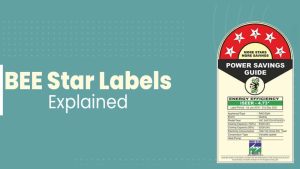If you manufacture electrical appliances in India, getting BEE Registration in India is mandatory to comply with government rules and build customer trust. This complete guide will explain the process, documents, and benefits for manufacturers.
What is BEE Star Labelling & who needs it?
- The Bureau of Energy Efficiency’s Standards & Labelling (S&L) programme assigns star ratings to appliances. Some product categories are under mandatory labeling and others are voluntary — manufacturers, traders, and importers of listed products must follow the rules for model and brand registration.
Quick overview: The 6 main steps
- Check whether your product’s covered under BEE S&L .
 Product testing at an approved / NABL-accredited lab per BEE test protocol.
Product testing at an approved / NABL-accredited lab per BEE test protocol.- Brand/Company (User of Label) registration on the BEE Standards & Labelling (S&L) e-portal.
udit.beeindia.gov.in - Model registration: upload test reports, documentation and model details; pay fees.
- Label approval & printing: approved label specimen and label usage rules.
- Compliance & surveillance: maintain records, production data, renewals and respond to check testing.
Step 1 — Does your product fall under BEE S&L?
- Visit the BEE S&L schedule/list and check whether your product family (e.g., room AC, refrigerators, geysers, TV, LED lamp, inverter, etc.) is in the mandatory schedule or voluntary schedule. If it is mandatory, compliance is required to sell in India.
Step 2 — Product testing
- Get samples tested as per the BEE test protocol for your product. Test reports must come from NABL-accredited labs — the model registration requires original test reports showing source performance values. Prepare test data in prescribed BEE format.
Action checklist: choose a NABL lab → book tests → send samples with user manual & tech specs → get test report in BEE format.
Step 3 — Brand / Company (User of Label) Registration on S&L e-portal
- Create an account and register the User of Label / Brand on BEE’s S&L portal. Once the brand/company is geting, you will receiv login credentials enabling model registration. The S&L portal is the official route for all applications.
Documents commonly needed (submit online; hard copy may also be required): covering letter, signed online form agreement between BEE and user of label, trademark certificate, factory license/address proof, ISO or QMS certificate, SSI certificate, authorization letter for signatory.
Step 4 — Model Registration
- For each product model you want labeled you must apply for model registration: upload test report, model technical detail, specimen of BEE label, and pay the model registration fee. BEE will scrutinize documents and test results before granting model registration.
Note: Model registration fees and exact annexure forms differ by product; follow product schedule instructions on the S&L portal.
Step 5 — Labeling, printing and product marking
- After approval, you will receive permission to use the BEE star label. Use the exact approved label specimen on the product and packaging as per BEE rules. Maintain label inventory records and ensure correct labelling on all units sold.
Step 6 — Surveillance, check testing & renewals
- BEE (or its agencies) conducts check testing by drawing samples from market/dealers to verify claims. Tests are done in empaneled NABL lab; if a model fails, BEE may direct corrective measure, re-test, or publish detail. Renewals and periodic reporting of production & labeling fee are mandatory schedule.
Documents checklist
- Covering letter
- Online company registration form
- Agreement between BEE & User of Label
- Trademark certificate
- Factory license / IEC / GST / address proof
- Test report from NABL-accredited lab
- Specimen BEE label + product photo showing label placement
- ISO 9001 / QMS certificate
- SSI certificate
(Exact lists may vary with product — check portal instructions)